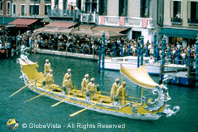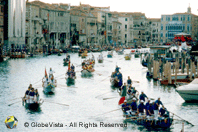Historical Regatta
 The Regatta Storica (Historical Regatta) is a long honoured annual event held in early September on the Grand Canal of Venice. The boating spectacular sees the Grand Canal closed to general watercraft and replaced with a cortege of traditional boats with their crews dressed in historical costumes.
The Regatta Storica (Historical Regatta) is a long honoured annual event held in early September on the Grand Canal of Venice. The boating spectacular sees the Grand Canal closed to general watercraft and replaced with a cortege of traditional boats with their crews dressed in historical costumes.
The city comes to a virtual standstill in the late afternoon as the sun lazily begins to fade and the canal becomes a sea of colour, sound and Venetian watercraft. Crowds gather along the canal, locals sit in windows, and the lucky enough to have their own boats soak up the last few rays of the sun from the best  vantage points on the canal.
vantage points on the canal.
Gondolas, pupparins, mascaretas, caorlinas, gondolinos, balotinas, sandolos, the twelve-oar Dodesona della Bucintoro and the eighteen-oar Disdotona are just some of the vessels which take part in the event.
The regatta begins with a historical procession of traditional boats led by the ‘Bissone’ (boats of state), as well as many other boats from the Venetian rowing society. Each boat is brightly coloured and the crews are dressed in traditional costumes. The procession is followed by the traditional Sardinian boats called fassoniss.
Just before five in the afternoon, the races begin. They start at the ‘Giardini della Biennale'(Napoleonic Public Gardens), from there the boats cross the basin of Saint Mark’s, then enter the Grand Canal.  They then row along the canal as far as the Church of Santa Chiara, where there have to turn around a post in the middle of the Canal called the ‘paleto’.
They then row along the canal as far as the Church of Santa Chiara, where there have to turn around a post in the middle of the Canal called the ‘paleto’.
Once around the post, they head to the finishing line at Ca’ Foscari. The first race is for the young oarsmen on the ‘pupparini’ boats (two oars), followed by the women on the ‘mascarete’ boats (two oars) , then the Regatta Delle Caorline for men on ‘caorline’ boats (six oars) and then finally finishing with the Regata dei Gondolini for champions on ‘gondolini’ boats (two oars).
 The races are taken very seriously by the rowing clubs participating and the action is fast and furious with many thrills and spills. It’s no wonder, the event is steeped in history and honour and there is a lot at stake. See the history section for more details.
The races are taken very seriously by the rowing clubs participating and the action is fast and furious with many thrills and spills. It’s no wonder, the event is steeped in history and honour and there is a lot at stake. See the history section for more details.
The winners of each event are presented with a coloured flag that represents their placing, first, second, third or fourth.  They are presented with the flag from the machina, a highly decorated wooden floating pontoon, located at “in volta Canal” (the bend of the canal) near the finishing line.
They are presented with the flag from the machina, a highly decorated wooden floating pontoon, located at “in volta Canal” (the bend of the canal) near the finishing line.
Brief History of the Regata Storica
The first known regatta in Venice dates back to the 13th century and was linked to “Festa delle Marie” ( Feast of the Mary’s) which was a celebration held in honour of the Madonna and Christ. It later became a way to train oarsmen. Images of the regattas began to appear in 16th century most notably on Jacopo de’ Barbari’s map of Venice. From the 15th to 16th century the event was organised by the  Compagnie de Calze, a group whose role was to keep the city festive and the people entertained. It was later handed over to regatta managers who funded the event via private individuals and locals who had been fined for refusing to participate.
Compagnie de Calze, a group whose role was to keep the city festive and the people entertained. It was later handed over to regatta managers who funded the event via private individuals and locals who had been fined for refusing to participate.
It didn’t take long for regattas to become a popular event and a regatta was often called to celebrate Doges being elected into office or for the sake of special guests who were either in Venice for private or official occasions. Some of the most celebrated and memorable regattas were in honour of Beatrice d’Este, Duchess of Milan (1493), Anna de Foix, Queen of Hungary (1502), Henry III, King of France (1574), Japanese Gentlemen (1585), Federick IV, King of Denmark (1709), Edward, Duke of York (1764), and Leopold II, Emperor of Austria (1791). It is remarkable, even following the fall of the Republic in 1797, the one thing that remained unchanged was the regatta. In fact the most memorable regatta of them all was held in honour of Emperor Napolean Bonaparte (1807). During  the 18th century the event became a popular theme amongst the Venetian painters, including Canaletto, Michele Marieschi and Francesco Guardi.
the 18th century the event became a popular theme amongst the Venetian painters, including Canaletto, Michele Marieschi and Francesco Guardi.
The regattas were taken very seriously, not just by the contestants but by the church as well. There was a lot riding on the shoulders of the rowers. On the eve of each regatta the oarsmen would go to the Church of della Salute and give offerings of oil and candles in hope it would bring them luck. The priests from the parishes, where the rowers resided, would bless the gondoliers and their boats (which often carried sacred images on board) before the race.
If the oarsman won the flag it would often be placed on the altar at their parish church. In 1841 the regatta officially became an annual event that became funded by the public rather than the private sector. In 1899 the regatta became known as the “historical” regatta thanks to the mayor of Venice, Count Filippo Grimani.
 Today the Regatta Storica is a celebration of the Venetians glorious past, present and future. “The Historical Regatta is a special, solemn and compelling institution. Firstly because a regatta on gondolini or on caorline is an event particular to Venice, belonging exclusively to its history, its tradition and to its very civilization.” (Paolo Costa, Mayor of Venice, 2001)
Today the Regatta Storica is a celebration of the Venetians glorious past, present and future. “The Historical Regatta is a special, solemn and compelling institution. Firstly because a regatta on gondolini or on caorline is an event particular to Venice, belonging exclusively to its history, its tradition and to its very civilization.” (Paolo Costa, Mayor of Venice, 2001)
Interesting Facts About The Regatta
Venetian women have been participating in regattas since 1493, when a group of scantily dressed women competed in honour of Beatrice d’Este, Duchess of Milan.
Maria Boscola da Marina was an undisputed female rowing champion for forty years during the 1700s.
 Scoazzere boats were used to transport rubbish (scoazze) out of Venice.
Scoazzere boats were used to transport rubbish (scoazze) out of Venice.
The regatta was originally followed by peote and ballotine boats whose job it was to keep law and order during the races. Men armed with bows would shoot terracotta balls at any disruptive or unruly contestants (that’s got to hurt).
The fourth-placed flag was originally yellow and had a pig on it. When the winners received their flags all but the fourth-placed winner received a bag of money. I don’t know whether it was an insult, but the fourth-placed rower was given a live piglet. Today the flag colour has changed to blue and the pig has gone.
The people on the processional gondolas wear correctly detailed Renaissance costumes.
